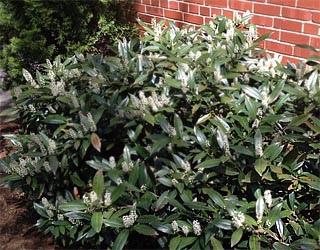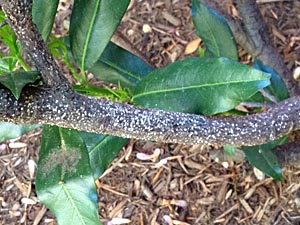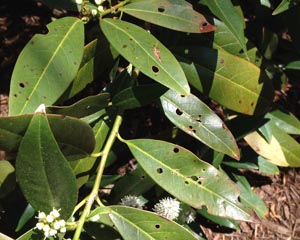Laurels May Be Hardy, But Beware of Problems
By Gil Medeiros, former Fairfax Master Gardener
Laurels have become very popular landscape plants in Northern Virginia. I am referring to Cherry Laurels (of which the Otto Luyken cultivar is heavily used) and Skip Laurels. These shrubs are related to peach, plum, and other stone fruits. They are prized for their shiny deep green leaves year round, white flowers in the spring, and deer resistance. That last attribute probably put the laurels over the top here in Fairfax County where deer now visit most neighborhoods on a regular basis.

Otto Luyken Laurel
For all of the positive aspects of the laurels, they do suffer some problems. Here are the two most common ones and what you should do about them.
White Peach Scale (WPS)
This is a serious problem. The incidence of WPS is widespread and increasing fast. Scales are tiny insects that insert their sucking mouthparts into the plant and feed on sap that is rich in carbohydrates. If enough of them feed on the sap of a plant – and the population may grow rapidly on a single plant — the plant may be seriously weakened and die.
Most home gardeners are not aware of WPS on their Cherry Laurels until they see brown leaves indicating dieback of a small branch. Further examination reveals a white and tan crusty coating on the bark of the dead branch and more on adjacent branches.

WPS on Otto Luyken Laurel
While armored scales are difficult to control, they do have two vulnerabilities:
- Both mature and immature forms of WPS need to breathe; they do this through holes on the sides of their bodies. If the holes are blocked — as by a light coating of oil – the insects may be suffocated.
- The immature newly hatched insects need to be mobile for mating and finding a feeding spot. This is called the “crawler stage.” Crawlers have not yet developed their armored shell, and during this period of 2 – 3 weeks, they are vulnerable. In Fairfax County, there are three generations of WPS crawlers each year. The crawlers are usually on the move from April 25 – May 15, July 1 – 15, and August 20 – September 15.
What to do
There are several options for your consideration. Since WPS is a formidable insect pest, you may employ some of these in combination.
- Prune out branches that are dead or dying. The pruned branches should be disposed in the trash. Maintain plant health by watering during periods of drought.
- Scrub the scales off. WPS attaches firmly to the branch, but they may be removed using a soft brush and soap and water. This is a fairly effective control for small infestations, but, as I can attest, it is tedious for larger infestations located on branches that are interior and low on the shrub.
- Spray with horticultural oil to suffocate the insects. Horticultural oil sprays are readily available at garden centers and big box stores. I recommend using a hose-end sprayer which attaches to your garden hose. This helps the user apply a thorough coating of oil to all branch surfaces. Timing is important. The horticultural oil sprays work best when they are applied just before eggs hatch in spring. Spray during late March or early April when temperatures are expected to stay above 40 degrees Fahrenheit for 12 – 24 hours. Be sure to follow label instructions.
- Use an insecticide, but it has to be the right insecticide applied at the right time. According to the Virginia Pest Management Guide, products containing Imidacloprid are effective against WPS. Such products are available at garden centers and big box stores. You will want to obtain one that is applied to the soil around the plant, not sprayed on the plant. This is called a soil drench. Imidacloprid is taken up by the roots of the plant and distributed to the branches and leaves. Control is achieved when the WPS insect under its armored shell feeds on the plant sap containing the insecticide. Applying Imidacloprid is easy for the homeowner; mix it in a bucket and pour it on the soil under the plant according to label instructions. The best time for application is late fall, but it may be applied anytime as long as the ground is not frozen or water-logged. Bear in mind that this insecticide works slowly, and the plant may not deliver enough of it to the affected branches to kill all of the WPS. Repeat applications are likely to be required.
- Call in a pro. If you are not inclined to handle oils and insecticides, call in a professional pesticide applicator. They have access to effective chemical treatments that are either not available or not practical for a homeowner. The arborist will likely apply a professional spray product containing Buprofezin or Spirotetramat while the crawlers are active (May 1 – 10, July 5 – 15, and September 1 – 10).
Shot Hole Disease

Shot Hole
What to do
Maintain the overall health of the plant by keeping it well watered during drought, but avoid overhead watering. Prune out severely affected areas and remove dead leaves from beneath the plant. That is about it. There are no approved chemical treatments listed in the Virginia Pest Management Guide.
References
Scale Insects, VCE Publication ENTO 106NP, 2015
VCE Pest Management Guide, Home Grounds and Animals, 2015, Table 4-5
Home and Garden Information Center 1069, Clemson Cooperative Extension, 1999